Fuel-Saving Secrets: Why F1 Cars Conserve Fuel While F2 Cars Go All Out
October 29, 2024
by Rowland Jowett
Ever wondered why F1 teams often under-fill their cars to save weight, unlike F2 teams that drive flat out? Did you know that F1 cars are more efficient than a Toyota Prius? Fuel economy might not seem crucial for racing, but it is a key strategy in F1.
F1 cars use about 100kg of fuel for a 300km race, F2 cars use around 70kg for 170km. There is a significant drop in speed from Q3 to race start due to this fuel load, in this article we explore how to minimise this extra mass added to the car.
Efficiency and Regulations
F1 cars are incredibly efficient, achieving 52% thermal efficiency compared to 40% for a Toyota Prius. This high efficiency is driven by FIA regulations that limit fuel flow, pushing teams to maximise power from every drop of fuel. The regulations mean that if teams are restricted on fuel flow, the only way to get more power is to improve efficiency. Canopy/Michelin laptime simulation can be used to further reduce fuel consumption giving the cars a fuel weight advantage.
The Weight Advantage
As Colin Chapman of Lotus Cars famously said, “Adding power makes you faster on the straights. Subtracting weight makes you faster everywhere.” This principle is at the heart of F1’s fuel strategy.
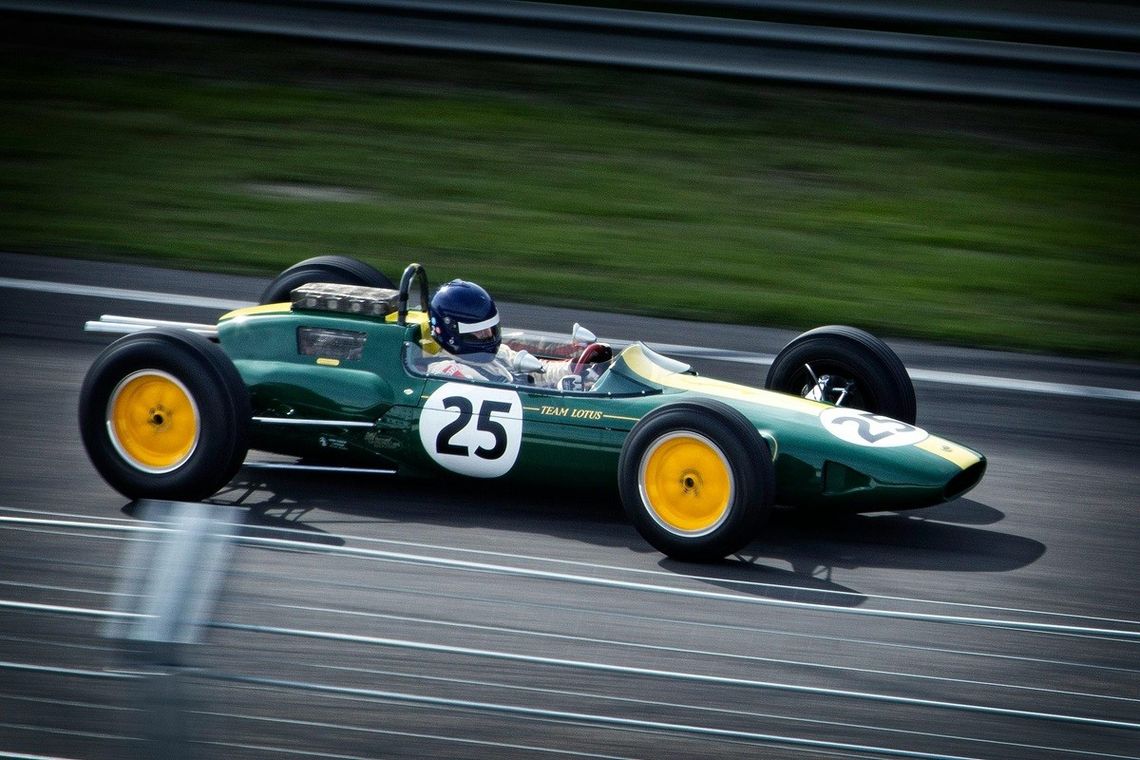
By starting with less fuel, F1 cars are lighter and faster in the crucial opening laps. For example, starting with 98kg instead of 100kg can give a significant advantage. This weight reduction is crucial because modern F1 and F2 cars have a minimum mass, including the driver, to prevent excessive dieting. Therefore, the only opportunity to make the cars lighter is to put in less fuel.
Optimal Fuel Saving Strategy
Using advanced Canopy/Michelin laptime simulations, the optimal strategy is to start the race flat out and gradually increase fuel saving. By mid-race at Singapore, F1 drivers should aim for around 2% fuel saving, ramping up to 4% by the end. This approach complements the need to fight for track position at the start with a focus on fuel efficiency later. The strategy involves burning fuel quickly at the start to reduce total car mass near the beginning, benefiting from a lighter car, and then paying this debt back with increased fuel saving towards the end.
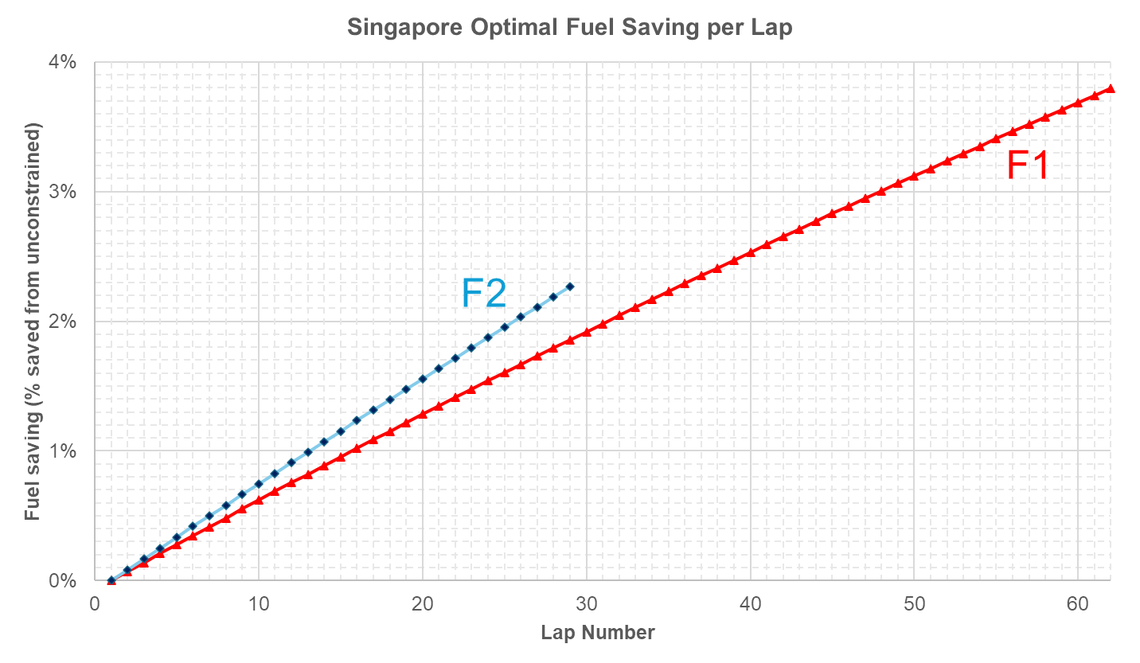
For anyone interested in reproducing this analysis, an exploration was run in Canopy on car mass and fuel consumption per lap. A polynomial was fitted so that laptime could be expressed as a function of total car mass and fuel saving (delta to unconstrained). Excel was used to calculate cumulative car mass based on fuel consumption working backwards from the final lap with zero fuel left to find starting total car mass. The Solver Add-In was then used to pick fuel saving for each lap to minimise total stint time.
Why F2 Gains Less
This optimal strategy in F2 yields only a 0.21 second advantage compared to 1.57 seconds in F1.

*F2 car simulated at Singapore, this track is not on their calendar, but it will later become clear why this circuit is particularly important.
F2 cars benefit less from fuel saving for two main reasons:
Race Distance: In shorter races, like those in F2, there is less time to accumulate significant weight savings. An F1 car, on average, is 1.36kg lighter over this race due to fuel saving, while an F2 car is only 0.53kg lighter.
Mass Sensitivity: Cars with more downforce, like F1 cars, are more affected by additional weight. F2 cars have less downforce, so they are less impacted by weight, making fuel saving less beneficial. The reason for this is explained below.
Understanding Mass Sensitivity
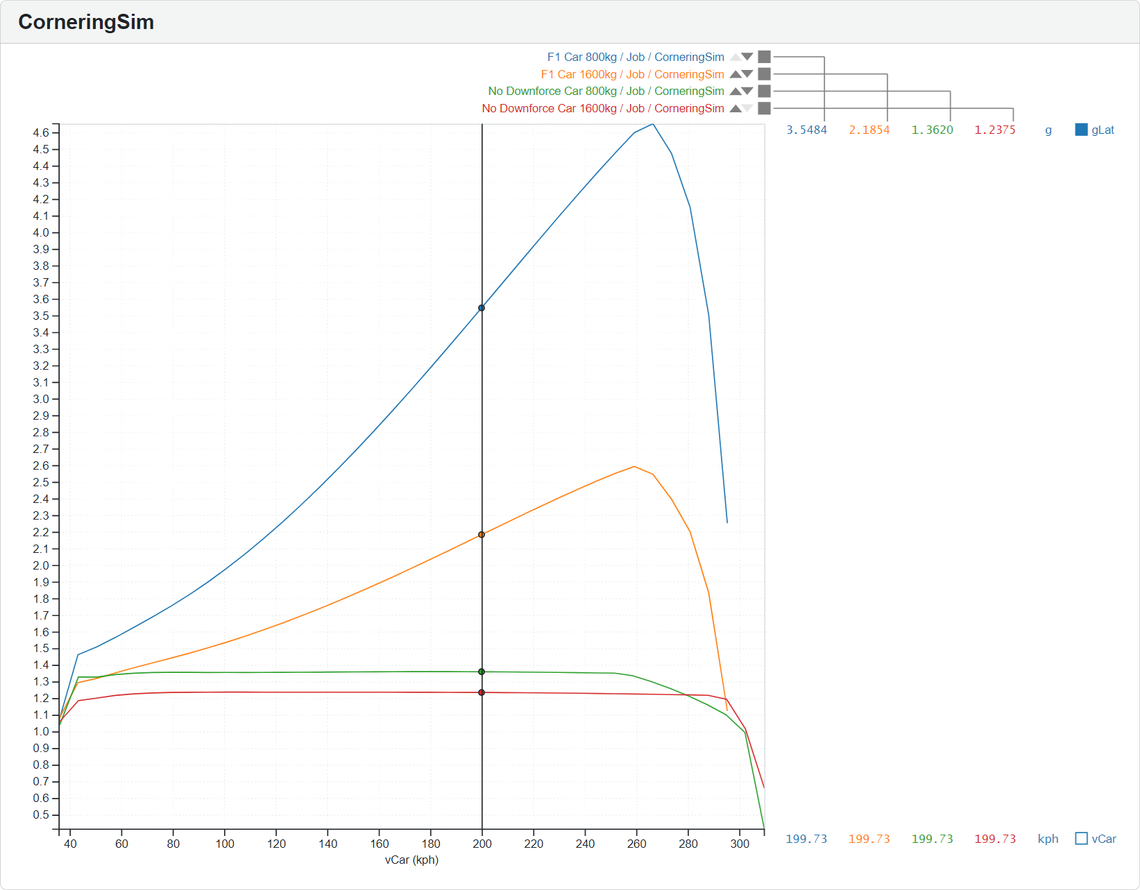
Cornering Sim shows the maximum lateral g-force (gLat) that can be achieved at each car speed (vCar).
An F1 car at 200kph can corner at 3.5g, but doubling its mass reduces this to 2.2g, a 42% drop. In contrast, a zero-downforce car’s cornering potential only drops from 1.4g to 1.2g when its mass is doubled.
Without downforce, doubling the car’s mass doubles the cornering force but also doubles the vertical load on the tyres thus maintaining similar cornering speeds. However, in F1, the downforce provides much more grip than the car’s weight. So, doubling the mass does not double the vertical load, leading to a significant drop in cornering speed.
F2 cars, with less downforce, are less affected by mass changes, making fuel saving less beneficial for them compared to F1 cars.
Circuit Characteristics
Circuit design plays a crucial role in fuel saving strategies. The balance of circuit mass sensitivity minus fuel saving opportunities determines the benefit.
Tracks like Singapore, with short straights and tight corners see the car’s mass under frequent acceleration and braking resulting in a high mass sensitivity, plus the circuit has many small braking zones that can be used as fuel saving opportunities.
Conversely, tracks like Spa, with long straights, do not see the car mass accelerating and braking so often and offer fewer regions to save fuel.
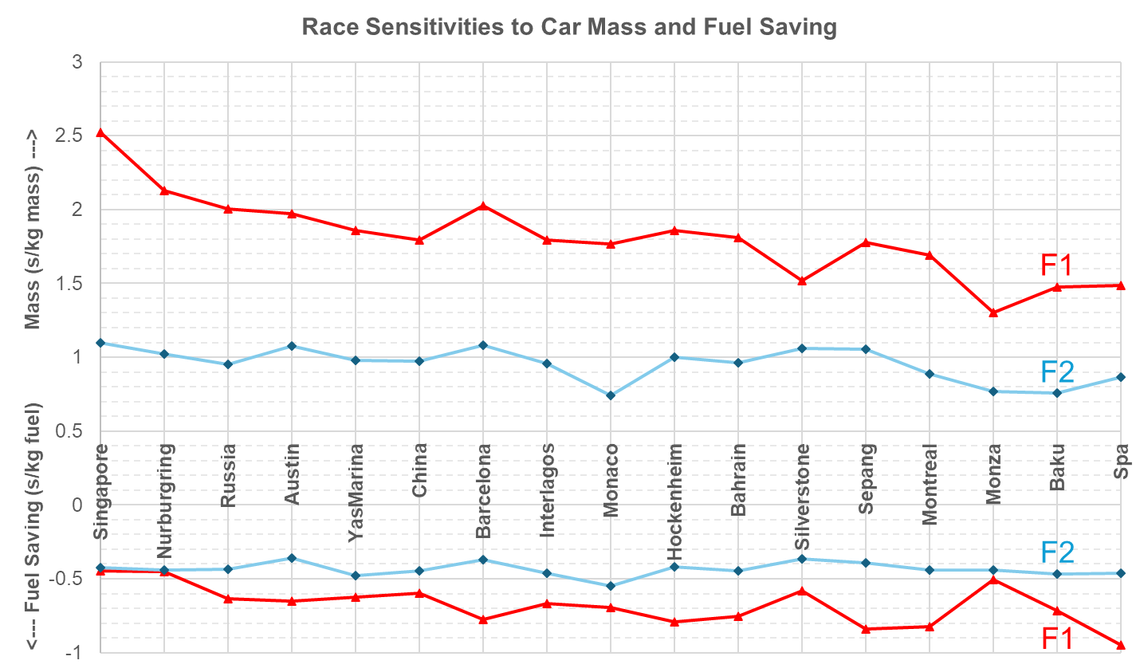
At Singapore, the sensitivity to mass is very high, 1.1 seconds per kg in F2 and 2.5 seconds per kg in F1. The fuel mass saving potential in F2 should be greater than F1 since the F2 cars use around 40% more fuel per lap. However, when multiplied by the race distance, there are fewer laps to save fuel over, so the race fuel sensitivity of -0.42 seconds per kg is slightly less than F1 at -0.44 seconds per kg.
At Spa, the mass sensitivity is very low at 1.5 seconds per kg in F1, while the opportunities for fuel saving are poor, costing -0.9 seconds per kg.
Safety Car Factor
The presence of a safety car can dramatically affect fuel strategy. Under-fuelling can save considerable time if a safety car appears. The F1 website suggests a 100% record of a safety car in Singapore, which might save around 2kg of fuel due to slower driving. Without planning for this eventuality, the starting fuel load would be more than required to complete the race and might result in a disastrous 5 second race loss from carrying unnecessary mass.
It is crucial to take safety car risk and optimal fuel saving into account. If there turns out to be no safety car during the race, stick to the planned fuel saving strategy. If there is a safety car, then the fuel saving can be done during this period and the rest of the race can be driven flat out.
Circuit Rankings
By combining the mass and fuel sensitivities, the optimal fuel saving percentage and race time saved can be determined for all circuits. Both formulae should aim for at least 0.5% fuel saving at all races, plus any expected safety car saving. However, F2 teams might not prioritize this as the total race time saved is on average 0.2 seconds compared to 0.6 seconds in F1.
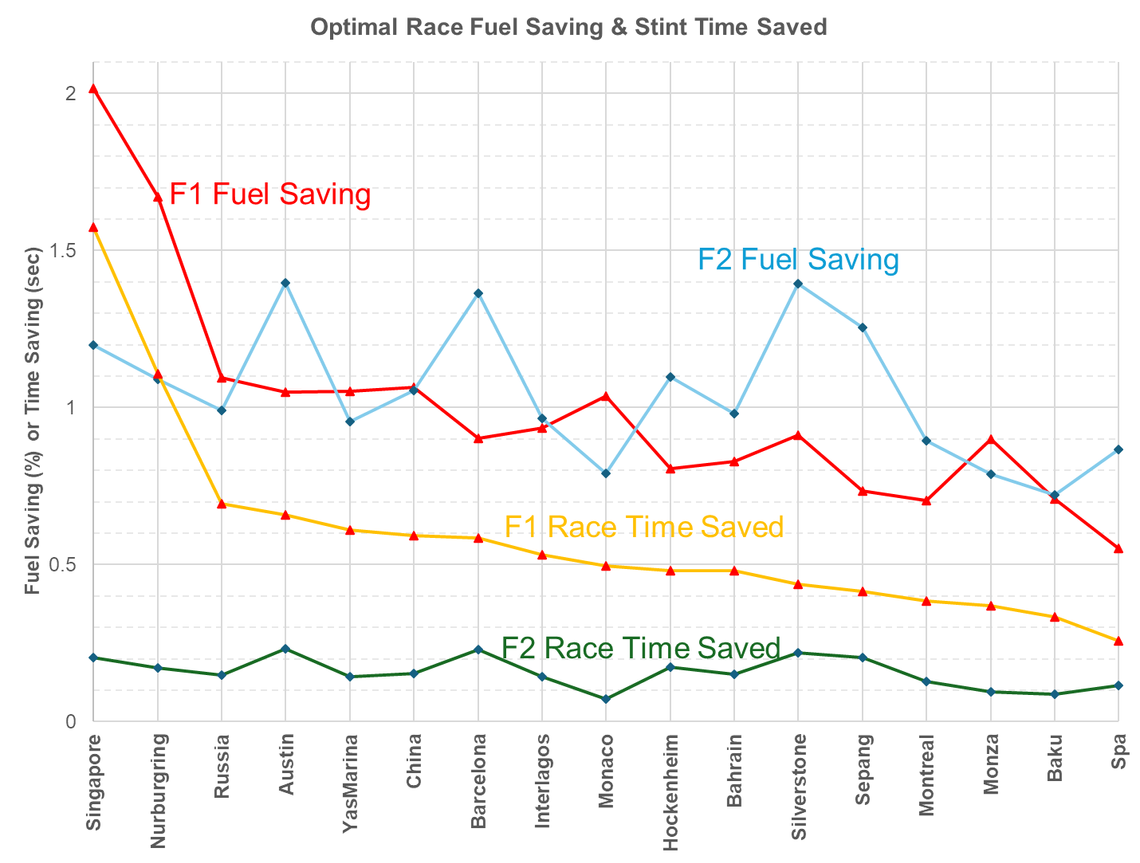
Circuit ranking of fuel saving benefit.
Interestingly, the percentage of fuel saving required is very car and circuit specific, with optimal fuel saving at Barcelona and Silverstone being significantly higher in F2 at 1.4% versus 0.9% for these circuits in an F1 car.
Some corners that are flat with F1 car downforce may require a more pronounced lift in an F2 car, resulting in additional acceleration and braking zones thus increasing the F2 mass sensitivity and making the ranking car dependent.
Tyre saving
The benefits of fuel saving extend beyond improving car mass. Driving in a way to save 2% fuel also results in a 1.3% reduction in tyre sliding energy at Singapore. This combined benefit of fuel and tyre saving shall be explored in future articles.
Conclusion
Fuel saving in motorsport is a strategic and engineering challenge that requires careful planning and execution. The optimal strategy in F1 at Singapore before safety car considerations involves 2kg under-fuelling, starting the race at full speed to quickly reduce the car’s weight, then gradually ramping up to 4% saving for the final laps. This approach, determined through laptime simulation, can save up to 1.57 seconds in a race, a significant proportion of the gap between 2nd and 1st place.
In races with a high likelihood of a safety car, under-fuelling should perhaps be double to save an additional 5 seconds by avoiding the unnecessary fuel mass.
Understanding the balance between mass, fuel efficiency, and circuit characteristics is crucial. Each race presents a unique set of challenges, requiring teams to adapt their strategies to gain an edge. It is particularly effective at Singapore, where frequent acceleration and braking increases the mass sensitivity and provide ample opportunities for fuel saving, combined with a high probability of safety car. On the other hand, tracks like Spa, with long straights, offer fewer chances to lift off the throttle, making fuel saving less beneficial.
Moreover, the benefits of fuel saving extend beyond just reducing car mass. Driving in a way that conserves fuel also reduces tyre wear, leading to better overall performance. This dual benefit adds another layer of complexity to race strategy.
Want to learn more about the cutting-edge strategies in motorsport? Stay tuned for more optimal discourse.